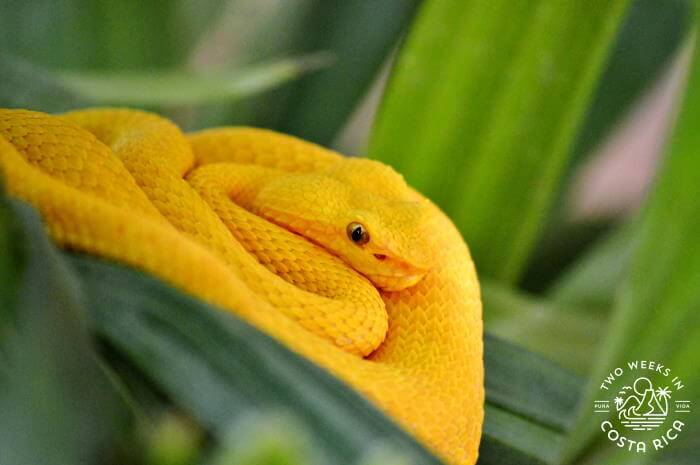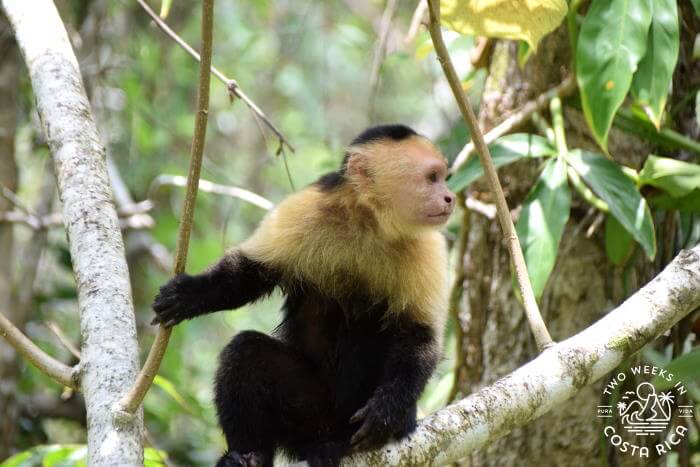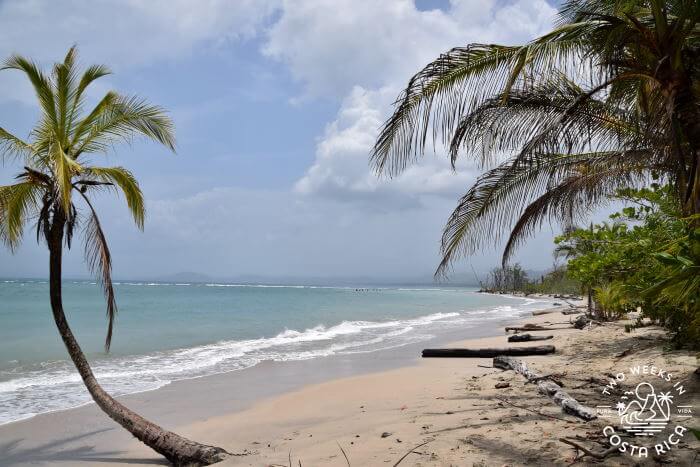Last Updated: February 9, 2024
Costa Rica is known for its impressive diversity of wildlife. To see species like sloths and monkeys, you can book excursions into the country’s most remote regions. But it doesn’t always have to be so extreme. One place, which is packed with wildlife but just minutes from civilization, is Cahuita National Park. In this post, we’ll give you all the information you need to plan your visit to this wildlife-rich park.

About Cahuita National Park
Cahuita National Park is located near the small town of Cahuita on Costa Rica’s southern Caribbean coast. It is about 4.5 hours from the capital of San Jose.
The protected area of Cahuita National Park totals an impressive 1,068 hectares (2,639 acres) of land and 22,400 hectares (55,351 acres) of marine zone. Included in this are several different habitats. There is lowland primary forest, secondary forest, tidal mangrove, beach, and coral reef.
Because most of the park sits on a point, wildlife almost seems to be funneled toward the trail.

Accessing Cahuita National Park
Cahuita National Park has two entrances.
Playa Blanca Entrance
Located just steps from the southern end of downtown Cahuita is the Playa Blanca entrance.
This sector of the park is run by a community organization. Admission is by donation. Funds go toward helping maintain trails and increasing signage. They also employ locals to help visitors and provide security.

Puerto Vargas Entrance
An alternative entrance, Puerto Vargas, is 5 km (3 miles) south of Cahuita, right off the highway.
The Puerto Vargas sector is administered by Costa Rica’s park service (SINAC). Admission fees are set by the government. (See section below on planning your visit for ticket prices.)
Hiking Trails at Cahuita National Park
Cahuita National Park’s two entrances are connected by the same trail system.
Since most people start from the Playa Blanca station in Cahuita and end at Puerto Vargas, that’s how we explain the hike in this post.
This hike is a total of 8.3 km (5.1 miles), one way. At the end from the Puerto Vargas station, you can hike back or take the public bus or a taxi back to town.
Because many people won’t hike the entire trail, below we divide the trail description into sections so you can decide which parts to do.
Trail Section 1 – Playa Blanca to Rio Suarez (Most Popular)
Trail Conditions
Starting from the Playa Blanca entrance, the main trail runs south along the jungle-backed beach for about 1.5 km (0.93 miles). You’ll meander close to the sand at times and into the thicker, humid jungle at others. Large trees hover overhead, offering some good shade. Lush, shrubby underbrush fills the sides of the wide trail.
The path soon leads onto the beach. Here, it meets the Rio Suarez (Suarez River). To continue, you will need to cross.

River Crossing
On our last visit in September 2023, the Rio Suarez was completely dried up from abnormally low rainfall. However, this can change from year to year and even from day to day with a big rainstorm.
If there is water in the river, it won’t be that wide. However, the crossing still may be difficult at high tide or just after heavy rain. The water can be swift and knee-to-waist deep or more at times. Low tide is the easiest time to cross.

Tip: Overall, hiking conditions in the park are flat and fairly easy. The total distance, possible river crossing, and heat/humidity are the biggest challenges. If you are not up for fording a river, but still want a longer hike, you could start in reverse from the Puerto Vargas entrance, go to Cahuita Point, and then turn back. There is a newer boardwalk trail at Puerto Vargas that is a nice, easy stroll (more below).
What You’ll See: Birds and Snakes
At the beginning of the trail is some good birding. Right before the Playa Blanca entrance, there is a small river that empties onto the beach. Here, you can often spot Tiger Heron, Green Heron, Kingfisher, and other wetland bird species.
This first section of trail is fine for wildlife viewing, but also the busiest, which can scare off birds and animals. Still, be on the lookout for snakes like the bright-yellow eyelash pit-viper. Though these snakes are very poisonous, they are not usually aggressive as long as they aren’t provoked. You may see them curled up on short shrubs, especially near the raised boardwalk sections.

Trail Section 2 – Rio Suarez to Punta Cahuita
Trail Conditions
After the river crossing, the trail continues along the beach and through jungle. In about 2 km (1.25 miles), you’ll reach Punta Cahuita (Cahuita Point).
Along the shore near Punta Cahuita is a picnic table and small area to rest. Off the beach is a coral reef (one of the biggest in Costa Rica). Tour companies often take people here to snorkel offshore.
From Punta Cahuita, the trail turns southwest and passes Punta Puerto Vargas (Port Vargas Point), another snorkeling area.
Note that snorkeling in the park is only permitted with a guide.

What You’ll See: Monkeys and Sloths
The area between the Rio Suarez and Punta Cahuita always has been the best for wildlife sightings for us.
On our last visit, we saw both howler monkeys and white-faced capuchin monkeys. We also spotted a sleeping two-toed sloth near the picnic tables. On a previous visit, we even got to watch a three-toed sloth very close up as it was coming down from a tree!
Tip: Be careful around white-faced monkeys and raccoons. Both can get aggressive protecting their young or when they smell or see food. On one visit to the park, we were charged by an aggressive male monkey while we were eating a banana (yes, seriously!). Another hiker was scratched when a monkey tried to get into his backpack.
The claws and teeth of these animals can cause a nasty infection. Unfortunately, we were told that this behavior is because the animals have been fed by humans in the past. So please, never feed the animals.

Trail Section 3 – Punta Cahuita to Puerto Vargas Ranger House
Trail Conditions and What You’ll See
From Punta Cahuita, the flat trail continues for about 4.8 km (3 miles) alongside remote beach. There isn’t much shade along this stretch so there tends to be less wildlife.
Although there usually aren’t many animals, you can focus your attention on the beautiful coastline.
The beach next to the trail has pristine light sand and palm trees that lean towards the clear blue water. You may see seabirds roosting on old pilings, as well as iguanas and hermit crabs.

Once you reach Puerto Vargas house (not to be confused with the ranger station), you’ll find some basic amenities. The large wooden house has rustic bathrooms, showers, sinks, picnic tables, and first-aid supplies in case of an emergency.
Trail Sections 3 & 4 – Exiting the Park
Trail Conditions and What You’ll See
From the Puerto Vargas house, there are two options to exit the park. The old trail continues along the beach for about 2.3 km (1.4 miles).
Or the newer Cavitos Trail cuts inland through lowland primary rainforest. This trail meanders along a raised boardwalk for 2.1 km (1.3 miles).
We highly recommend using the Cavitos Trail so that you can see the impressive old-growth trees and abundant wildlife that lives in an otherwise inaccessible area. It feels as though you are walking atop the wetland. Lofty trees stretch overhead and exposed mangrove roots full of life lie below.

Both trails exit at the Puerto Vargas ranger station. From here, a short dirt road leads to the highway.
See below for the public bus schedule if you plan to catch a ride back to Cahuita.
Planning Your Visit to Cahuita National Park
Important – Zero Plastics
The park has a very strict no-plastic policy.
You will not be able to enter with plastic water bottles, plastic food wrappers, or single use plastic containers. We had dried fruit and granola bars in plastic wrappers and we had to take them out of their packaging and put them in a reusable Ziplock bag (yes, also plastic, but “reusable” ones that we purchased at the grocery store nearby). This process took about 30 extra minutes, so come prepared to save time!
Park Hours
Playa Blanca Sector: Open daily from 8:00 a.m. to 4:00 p.m.
Puerto Vargas Sector: Open daily from 8:00 a.m. to 4:00 p.m.
Cost: Self-guided Hiking
Playa Blanca Sector: Voluntary donation
Puerto Vargas Sector: $5.65 (with tax) foreigners. ¢1,130 (with tax) nationals and legal residents. Cash or credit cards are accepted.
*You do not need to buy tickets online in advance to visit Cahuita National Park.
Guided Tour Options
Guided tours are available from several operators in the area. Guides also wait outside the park and will negotiate a price with you.
If you would like to reserve someone in advance, we know a local naturalist guide that has outstanding knowledge. To book, please send us an email at bookings(at)twoweeksincostarica(dot)com. Include your preferred date and the number of people in your party (adults and children, with ages of kids).
Guided tours cost $60 adults, $30 children ages 6-11 and go from 8:00 a.m. to 11:00 a.m./12:00 p.m. Entrance and fruit are included. *Transportation available for an additional charge.
Public Bus Schedule
If you are hiking on your own and plan to return to Cahuita by public bus, you can find the schedule here.
What to Wear/Bring
We recommend lightweight clothing that dries quickly, sunscreen, a hat, and insect repellent. Read our post on preventing mosquito bites, which includes some recommendations for repellents that work well in Costa Rica.
Hiking boots or sturdy sneakers are ideal, especially if you plan to do the entire trail. Sometimes you will see people in flip-flops, but that’s not a great idea with snakes and biting insects around.
Don’t forget to bring plenty of water – a reusable water bottle or hydration pack.
Also be sure to bring some snacks. To avoid aggressive animals, make sure you have a Ziplock or dry bag that seals well.
Conclusion
Cahuita National Park has an impressive amount of wildlife, which seems just steps away. We have always enjoyed our hikes here and compare them to some of the wildest places we have ever visited in Costa Rica. We hope that if you visit, you’ll be able to experience it for yourself.
Have a question about visiting Cahuita National Park? Have you already been? Leave us a comment below.
Some of the links in this post are connected to affiliate programs we have joined. As an Amazon Associate we earn from qualifying purchases.
Last Updated: February 9, 2024
Looking for more information about Costa Rica’s Caribbean coast? Check out these articles:
Cahuita: Culture and Calm on the Caribbean – If you want to stay right near the park, check out our destination guide to this charming beach town.
Puerto Viejo de Talamanca: Caribbean Cool in Costa Rica – Puerto Viejo is another popular destination. It’s just 20 minutes south of Cahuita and has a little more going on. Read this post for some great hotel and restaurant options.
Tortuguero Off the Resort – If you’d like to see even more wildlife, Tortuguero is worth a stop. This town, accessible only by boat or plane, is famous for sea-turtle nesting.
